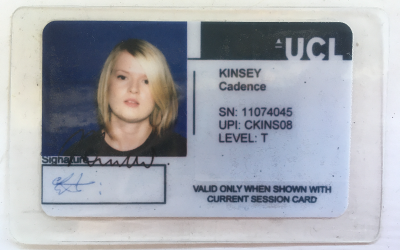UCL History of Art is a diverse and inclusive department; our 'Staff Journeys' series highlights the different routes that our staff have taken to get into their roles in art history.
My Journey as an Art Historian – Dr Cadence Kinsey
After two decades of trying to fit in with art history and academia, I am perhaps now starting to make art history and academia fit in a little more with me."“
A couple of years ago, I came across the extraordinary statistic that just 0.9% of UK secondary school pupils who come from a similar socio-economic background as myself will attend an elite university such as UCL at undergraduate level. Even thinking about this now makes me feel dizzy for having attempted such an unlikely leap into the unknown. Had I known this statistic before applying, I probably wouldn’t have even applied. The figures for progression to master’s or PhD, let alone to academic staff, must be even more shocking.

It was the way that the lecture demanded that we think about text and image together, all within an inherently interdisciplinary framework and grounded in the social, that felt absolutely unique and challenging in the best possible way. I was gripped. I’m not sure what my colleague would have thought at the time about someone sneaking in – although I have since told them! – but how else could I have found out about the subject?
And here another statistic is worth sharing – in 2022 only eight state schools offered History of Art as an A-Level. Again, had I known that with my background I would be in a minority, I might not have asked to transfer into the programme, but of course I am pleased that I did. After all, it was History of Art that taught me to think critically about the world around us and to understand the ways that injustice and inequality are perpetuated through representation in all its visual, textual, and legal senses.
Although historically the discipline might have recruited narrowly, it does not mean that there is anything inherently elite or elitist about History of Art. In fact, how it teaches us to think about the world feels increasingly relevant to all, and it is a highly desirable subject for entry into the creative industries, which account for 1 in 11 jobs in the UK according to the latest figures (correct in 2023) from the Department for Digital, Culture, Media & Sport.
In my role at UCL I have therefore been working to expand access to studying the subject for all, cutting the entry requirements so that prospective students who meet certain criteria can come to UCL with grades BCC at A-Level. I also hope to find ways to better support our under-represented student groups once they are here and to ensure that they are able to progress, should they wish, on to further degrees.
Indeed, this widening participation work has given me greater confidence to start to explore themes of inequality and social class within my own research. After two decades of trying to fit in with art history and academia, I am perhaps now starting to make art history and academia fit in a little more with me.
Social class is a notoriously difficult thing for people in the UK to speak about, even though it pervades every aspect of our everyday lives, no matter where on the socio-economic spectrum we fit or are made to fit. Class is not recognised as a protected characteristic here in the UK, yet it can have profound consequences: from life expectancy to the expectations for our lives that we are (or are not) encouraged to have. As my own experience bears out, this is felt acutely in education: affecting everything from where we will study to what.
It is not easy to put a positive spin on how difficult the journey to securing a permanent academic post has been. At every step there have been enormous financial, social, and academic demands, from balancing work alongside study, to assimilating and fitting in, to having to excel to secure scholarships for further study (as opposed to simply being ‘good enough’). I am acutely aware that for others, particularly for those who additionally experience racialisation and racism, the process is even harder.
As such, this ‘staff journey’ is not intended to be a deterrent, or even a motivational text to show it can be done. Instead, I hope that it can offer some representation and recognition for the extraordinary achievements of thousands of students across the UK who continue to strike out along this path every year, despite the odds. Maybe you are one of those reading this now. For anyone else, please read this.
 Close
Close

